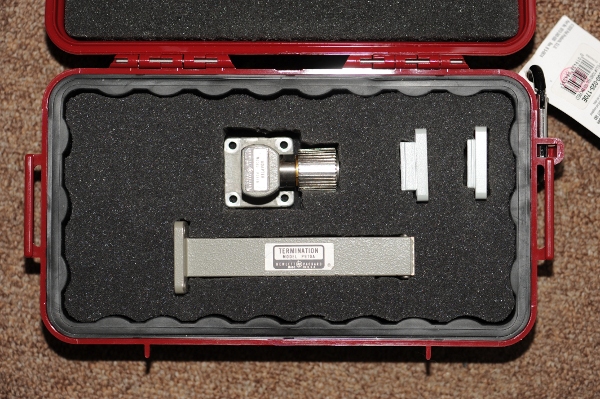

The Kirkby Microwave model Ku-WR62-4 is a low-cost VNA calibration kit for waveguide WR62, also known as WG18 and R120. The kit includes
Anybody using a calibration kit for waveguide is likely to know the basic principles of VNA calibration for coaxial devices. This page assumes that the user knows how to use a SOLT (short, open, load, thru) calibration kit for coaxial measurements. This page will concentrate on the differences from a coaxial kit, to a waveguide calibration kit, which works over a limited band - in the case of this kit, Ku-band.
For coaxial devices it is normal to use a short, open and load for calibration. The purpose of using the short and open is to provide the VNA with two voltages which are as close to 180 degrees apart in phase. An open reflects a signal in phase and a short out of phase, so the phase difference is close to 180 degrees. The magnitudes of the reflection coefficient are both close to 1, or a return loss of 0 dB.
For waveguide calibration it is not possible to use an open. Leaving the waveguide opens results in producing an antenna, with a return loss around 13 dB, at a phase which is not well defined. An open waveguide is therefore not suitable for VNA calibration. Instead it is usual to use two shorts, which differ in length by a quarter wave (90 degrees). Then the reflected signal is 180 degrees different from the incident signal. So the phase shifts are similar to what is achieved in coax. The use of two shorts is inherently narrow band, as a quarter wave at one frequency would be a half-wave at twice that frequency, which would result in the incident and reflected signals being in phase. It is the narrow band nature of the use of two shorts which makes it uncommon for coaxial calibration, although it is used for coax in some instances. However, the fact waveguide is normally used over a narrow range of frequencies means that the use of offset shorts is practical.
The following process is required for a single-port calibration.
For a two port calibration, the above should be repeated at the second port, then the two waveguide transitions joined for a zero length thru.
Either the lengths or the delays of the two offset shorts need to be entered into the calibration kit definition. Some VNAs need a length, and others a delay. The HP, Agilent, Keysight and Copper Mountain VNAs need a delay. It is possible that instruments from Anritsu or Rohde and Schwarz need a thickness. The depth of the shorts, will be given, and so the delay can be computed, taking into account the velocity of propagation in air, which may be assumed to be 2.996953 x 108 m/s. This is someone less than the velocity of propagation in a vacuum, which is defined to be exactly 299792458 m/s.
Kirkby Microwave Ltd is registered in England and Wales, company number 08914892. Registered office: Stokes Hall Lodge, Burnham Rd, Althorne, Essex, CM3 6DT.